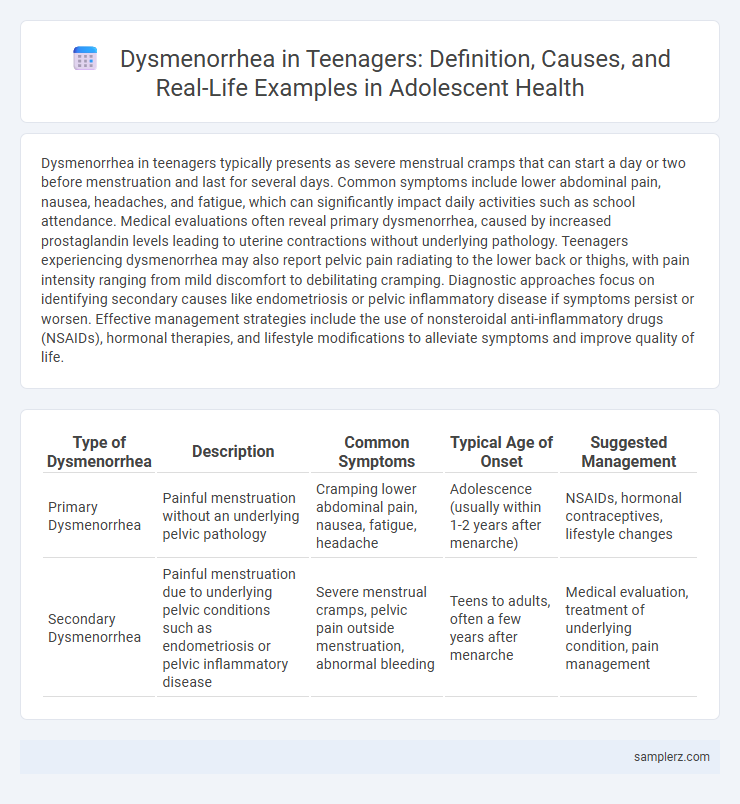Dysmenorrhea in teenagers typically presents as severe menstrual cramps that can start a day or two before menstruation and last for several days. Common symptoms include lower abdominal pain, nausea, headaches, and fatigue, which can significantly impact daily activities such as school attendance. Medical evaluations often reveal primary dysmenorrhea, caused by increased prostaglandin levels leading to uterine contractions without underlying pathology. Teenagers experiencing dysmenorrhea may also report pelvic pain radiating to the lower back or thighs, with pain intensity ranging from mild discomfort to debilitating cramping. Diagnostic approaches focus on identifying secondary causes like endometriosis or pelvic inflammatory disease if symptoms persist or worsen. Effective management strategies include the use of nonsteroidal anti-inflammatory drugs (NSAIDs), hormonal therapies, and lifestyle modifications to alleviate symptoms and improve quality of life.
Table of Comparison
| Type of Dysmenorrhea | Description | Common Symptoms | Typical Age of Onset | Suggested Management |
|---|---|---|---|---|
| Primary Dysmenorrhea | Painful menstruation without an underlying pelvic pathology | Cramping lower abdominal pain, nausea, fatigue, headache | Adolescence (usually within 1-2 years after menarche) | NSAIDs, hormonal contraceptives, lifestyle changes |
| Secondary Dysmenorrhea | Painful menstruation due to underlying pelvic conditions such as endometriosis or pelvic inflammatory disease | Severe menstrual cramps, pelvic pain outside menstruation, abnormal bleeding | Teens to adults, often a few years after menarche | Medical evaluation, treatment of underlying condition, pain management |
Understanding Dysmenorrhea in Teenagers
Dysmenorrhea in teenagers typically manifests as cramping pain in the lower abdomen occurring shortly before or during menstruation, often classified as primary dysmenorrhea linked to increased prostaglandin production. Studies indicate that up to 90% of adolescent girls experience this condition, which can significantly impact daily activities and school attendance. Effective understanding involves recognizing symptom patterns, severity, and distinguishing primary from secondary causes such as endometriosis or pelvic inflammatory disease.
Common Symptoms of Teenage Dysmenorrhea
Teenage dysmenorrhea commonly presents with cramping lower abdominal pain that occurs just before or during menstruation. Other frequent symptoms include nausea, headaches, and fatigue, which can significantly disrupt daily activities. These symptoms typically begin within a few hours of menstrual onset and may last for two to three days.
Primary vs. Secondary Dysmenorrhea: Key Differences
Primary dysmenorrhea in teenagers typically involves cramping pain during menstruation without underlying pelvic pathology, often beginning within a few years of menarche. Secondary dysmenorrhea arises from identifiable gynecological conditions such as endometriosis, pelvic inflammatory disease, or uterine fibroids, causing pain that usually worsens over time. Differentiating between primary and secondary dysmenorrhea is crucial for effective treatment, with imaging and clinical evaluation guiding diagnosis.
Real-Life Example of Dysmenorrhea in a Teen Girl
A 15-year-old girl experiences severe cramping pain during her menstrual periods, causing her to miss school and limit physical activities. Her symptoms include intense lower abdominal pain, nausea, and fatigue, typical signs of primary dysmenorrhea in teenagers. Treatment with nonsteroidal anti-inflammatory drugs (NSAIDs) and hormonal contraceptives effectively reduces her pain and improves her daily functioning.
Impact of Dysmenorrhea on School and Social Life
Dysmenorrhea in teenagers often leads to severe abdominal pain and fatigue, causing frequent school absences and decreased academic performance. The chronic discomfort limits participation in social activities, contributing to feelings of isolation and reduced peer interaction. Effective management strategies are crucial to minimize these impacts and improve overall quality of life.
Risk Factors for Dysmenorrhea in Adolescents
Risk factors for dysmenorrhea in adolescents include early menarche, heavy menstrual flow, and a family history of menstrual pain. Lifestyle factors such as high stress levels, low physical activity, and poor diet can also contribute to the severity of symptoms. Hormonal imbalances and underlying medical conditions like endometriosis increase the likelihood of experiencing severe dysmenorrhea during the teenage years.
Effective Home Remedies for Teenage Dysmenorrhea
Teenage dysmenorrhea can be effectively managed with home remedies such as the application of a heating pad on the lower abdomen to alleviate menstrual cramps and regular exercise to improve blood circulation. Herbal teas like ginger or chamomile contain anti-inflammatory properties that reduce pain and soothe discomfort during menstruation. Maintaining a balanced diet rich in omega-3 fatty acids and magnesium also supports uterine muscle relaxation and decreases the severity of menstrual cramps in teenagers.
When to Seek Medical Advice for Menstrual Pain
Severe dysmenorrhea in teenagers characterized by intense cramping, excessive bleeding, or pain disrupting daily activities warrants prompt medical evaluation. Persistent menstrual pain unresponsive to over-the-counter analgesics or accompanied by symptoms such as nausea, vomiting, or dizziness should prompt consulting a healthcare provider. Early medical intervention can help diagnose underlying conditions like endometriosis or pelvic inflammatory disease, ensuring effective treatment and improved quality of life.
Managing Dysmenorrhea: Lifestyle Tips for Teens
Teenagers experiencing dysmenorrhea can find relief through regular physical activity, which helps reduce menstrual pain by improving blood circulation and releasing endorphins. Maintaining a balanced diet rich in omega-3 fatty acids, vitamins B and E, and magnesium supports hormonal balance and decreases inflammation. Consistent sleep patterns and stress management techniques such as yoga or meditation also play a crucial role in minimizing the severity of menstrual cramps.
Long-Term Outlook and Prevention Strategies
Teenagers experiencing dysmenorrhea often face recurring pelvic pain that may impact daily activities and academic performance; long-term outlook improves with early intervention and consistent management. Preventive strategies include regular physical exercise, stress reduction techniques, and the use of hormonal contraceptives to regulate menstrual cycles and reduce pain severity. Monitoring and consulting healthcare providers for personalized treatment plans are essential to prevent complications like chronic pelvic pain and improve quality of life.

example of dysmenorrhea in teenager Infographic
 samplerz.com
samplerz.com